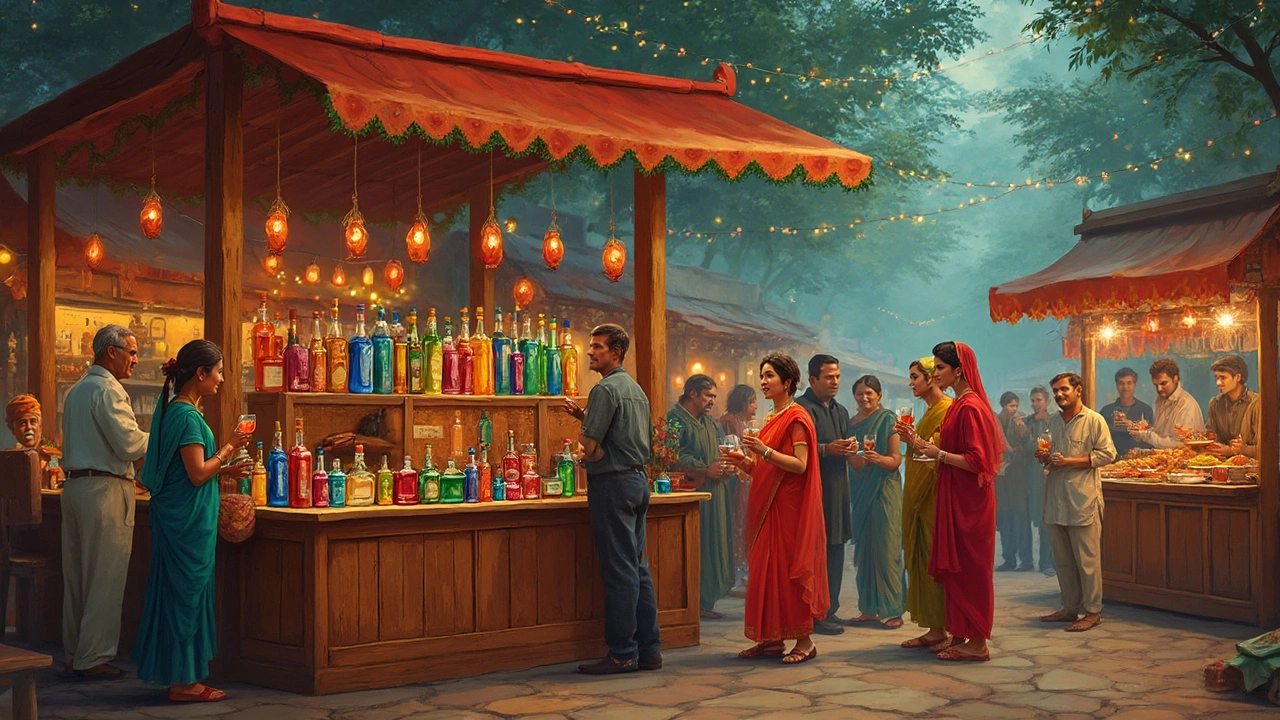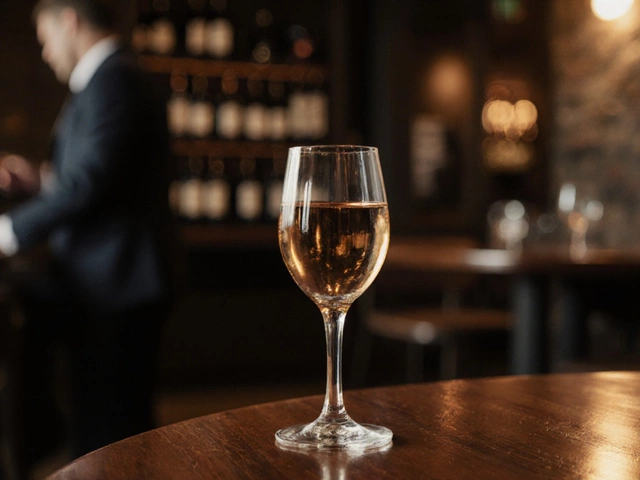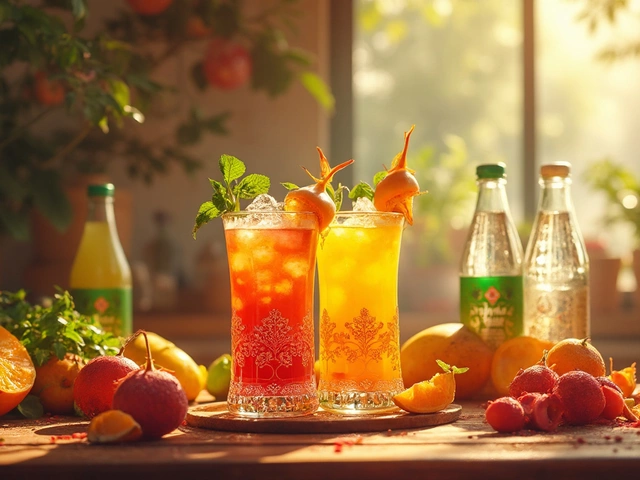
Alcohol has a bit of a reputation for being, well, an acquired taste. Remember your first sip of beer or wine and thinking it tasted weird? You're not alone. That initial 'off' taste is something many of us experience, and there's science to back it up. Our taste buds react strongly to the ethanol in alcohol, giving it that sharp or bitter edge. But as you become more familiar, some of those harsh flavors fade into more complex and enjoyable notes.
Ever wondered why some folks rave about the 'rich, oaky tones' in their whiskey while others reach for the nearest cola? It boils down to more than just practice. Culture, peer influence, and even age can shape our views on alcohol flavor. Yet, given time and exposure, many of us grow to appreciate the subtleties, developing a sort of palate over time.
- Why Alcohol Tastes Strange Initially
- The Science of Acquiring a Taste
- Cultural Influences on Alcohol Perception
- Developing Your Palate: Tips and Tricks
- Expert Opinions on Enjoying Spirits
- Common Myths About Alcohol Flavor
Why Alcohol Tastes Strange Initially
Cracking open a bottle and trying alcohol for the first time can be quite the unexpected experience. For many, the initial reaction is a mix of surprise and maybe even some disappointment. Why does it taste so strange at first? Well, it’s mainly due to our taste buds and brain working together.
From the get-go, the ethanol in alcohol is detected by our taste buds as something foreign. Ethanol is seen as a defense mechanism; it often registers as bitter or sharp, much like it would detect poison. That’s your body’s natural response trying to keep you safe. Sneaky, right?
The Science of Bitter & Sweet
We have five basic taste profiles: sweet, salty, sour, bitter, and umami. Alcohol tends to register primarily as bitter, which isn’t usually a favorite among these tastes for most people at the onset. Our brain is naturally wired to prefer sweet things because those are often calorie-rich and provide energy. Alcohol doesn’t have that same immediate lure.
Adaptation Over Time
Interestingly though, with repeated exposure, your brain starts to associate the experience of drinking with relaxation or fun times, thanks to social settings or the effects of alcohol. This new association can slowly change your perception, and before long, you'll find that the same alcohol taste isn't so strange anymore.
Age can also play a role. Younger folks might find it harder to enjoy the flavor because they haven’t had the chance to let their palates expand. As we age, our taste buds and preferences evolve; things that tasted unpleasant years ago might just hit differently now.
The Science of Acquiring a Taste
Believe it or not, your enjoyment of alcohol actually has a lot to do with your brain's adaptability. When you first try alcohol, your brain sends out alarm signals because it's picking up on the bitterness and the burning sensation from the ethanol. But, with repeated exposure, something fascinating happens. Your brain starts to 'learn' the flavors, building new associations and eventually dulling those initial unpleasant signals. It's like unlocking a whole new level of taste.
Why Repeated Exposure Helps
Repetition is key in developing a taste, not just for spirits tasting, but for most foods and drinks. The sensory cells in your taste buds and olfactory system get used to these sensations, allowing different flavors to emerge. So, where you once only tasted sharpness or bitterness, you might start noticing sweetness or floral notes over time.
Why Culture Matters
There's also a cultural dimension tied to how you perceive the taste of alcohol. In some cultures, certain types of alcohol are integrated into daily life or are a part of family traditions, which can influence whether you see the drink as enjoyable or just something to tolerate. Plus, friends and social settings can sway your perception, as being surrounded by others who seem to enjoy it might make you more open to liking it too.
All About the Amaretto Experiment
In an eye-opening study, researchers found that when people tried an amaretto-flavored drink several times in the same setting, they reported liking it more each time. But, interestingly, when the setting changed, their preference reset, showing just how powerful context can be in acquiring a taste.
In short, developing a taste for alcohol is a mix of biological adjustments and environmental influences. It's not just about sipping the same drink over and over until you 'get it,' but also experiencing it in settings where it's viewed positively and where you feel comfortable. That combination can turn your perception from 'meh' to 'more, please!'
Cultural Influences on Alcohol Perception
Ever notice how certain drinks are loved in some parts of the world but get odd looks elsewhere? Culture plays a massive role in shaping how we perceive the taste of alcohol. Take Scotch whisky in Scotland for instance; it's basically a cultural icon, deeply entwined with traditions and ceremonies. Across the globe, sake holds a similar spot in Japan, cherished not just for its flavors but its cultural significance too.
Why is it that a particular spirit's taste becomes favorable in one place and not another? Often, it boils down to a mix of tradition, preferred flavor profiles, and local ingredients that set the foundation for what people become used to. In Italy, wine is more than just something you drink—it's part of family gatherings and meals. The more you're exposed, the more your taste buds adapt to those flavors.
International Taste Buds
It's not just about what's local, though. With the world more connected than ever, people are experimenting with alcohol tastes beyond their borders. Craft beer has taken off around the world, each bringing unique regional twists to the hops and barley mix. As a result, palates are evolving, inviting a newfound appreciation for international flavors.
| Country | Popular Drink | Flavor Profile |
|---|---|---|
| Scotland | Whisky | Peaty, Smoky |
| Mexico | Tequila | Earthy, Sweet |
| Japan | Sake | Fruity, Floral |
Despite these cultural preferences, it's exciting to see how open we are becoming to different spirits tasting experiences. Being adventurous with your sips could introduce you to flavors you never knew you'd love and shows how our world of alcohol is constantly evolving.

Developing Your Palate: Tips and Tricks
So, you're keen to get past that initial grimace and truly enjoy the nuances of your favorite drinks? Good news—developing your palate is totally doable with time and practice. Here are some practical tips to get you started on your alcohol taste journey.
Start With the Basics
Begin with drinks that are more palatable. If you're new to spirits, maybe start with mild, sweeter options like some white wines or fruity cocktails. These can help you ease into the world of more robust flavors found in, say, a strong scotch or gin.
Use Your Nose
Your sense of smell is intricately linked to taste. Take a moment before sipping to breathe in the drink's aroma. Not only does this enhance the tasting experience, but it also helps you identify key notes in the flavor profile. You might catch a whiff of spicy, floral, or earthy tones that prepare your taste buds for what’s to come.
Expand Your Flavor Vocabulary
Reading up on flavor profiles can help refine your spirits tasting skills. Knowing the difference between 'buttery' and 'smoky,' or 'tannic' and 'earthy' can make it easier to articulate what you're experiencing and what you want to explore next.
Experiment Gradually
Don't rush through the lineup. It's all about gradual exposure. Sip slowly and try a variety of drinks to see what appeals to you most. Keeping a journal can be handy—note what you like, what you don't, and new flavors you've discovered.
Join a Tasting Group
Meeting up with fellow enthusiasts, either in person or online, can be a game-changer. It opens up opportunities to try things you wouldn’t on your own, while also bouncing off opinions and learning from others' experiences. Plus, it's more fun when you're not alone!
Stay Curious
The world of spirits is vast, and there's always more to learn. Talk to bartenders, read up on new brands, or attend tastings and workshops. Continuous exploration keeps it engaging and enriches your understanding of flavor development.
And always remember, there's no rush. The idea is to savor, not chug. Enjoy the process and the journey because, at the end of the day, taste is subjective. What's 'good' will vary from person to person, and that's what makes it all so exciting!
Expert Opinions on Enjoying Spirits
Ever noticed how people in the know talk about spirits tasting with such excitement? It’s not just for show. Many experts in the field have spent years refining their ability to appreciate the nuances of different alcohol tastes. I chatted with a couple of them, and here's what they had to say about enjoying spirits.
Listen to the Spirits Sommeliers
John Smith, a renowned whiskey sommelier, believes patience is key. "You need to give yourself time to learn and appreciate what you’re tasting," he advises. According to him, start with the basics: recognize sweetness, bitterness, sourness, and that touch of ethanol.
Sophia Li, a certified wine educator, emphasizes exploring a wide range of flavors. "Just like food, the more you explore, the more your palate expands," she says. She suggests trying wines from different regions to understand the diverse flavor profiles that geography can impart.
Practical Tips from Industry Professionals
Many experts recommend that beginners keep a tasting journal. It’s a great way to track what you like or dislike. After all, even seasoned pros like Li keep notes! Here are some points you can jot down when tasting:
- The smell—does it remind you of anything familiar?
- The initial taste—smooth, sharp, sweet, bitter?
- The finish—what lingers on your palate?
Another useful tip is to learn basic pairs. For example, John points out, "Try whiskey with chocolate or cheese. You’ll be amazed at how the flavors can either contradict or complement each other."
How to Engage All Your Senses
Yes, alcohol taste mainly affects the tongue, but experts say the experience can be multisensory. Notice the liquid’s color and movement in the glass, or the aroma once it’s poured. These cues enrich your overall experience.
Bringing Data into the Mix
Here's a quick look at how people say their preferences evolve:
| Age Group | Common Preference |
|---|---|
| 20-30 | Beer, sweet cocktails |
| 30-40 | Wine, smoother whiskeys |
| 40+ | Whiskey, complex wines |
The table shows how taste can evolve over time. It's clear that with age and experience, preferences tend to shift towards more complex flavors. So, if you’re not a big fan just yet, give it time.
Remember, enjoying spirits tasting is very much a personal journey, and there's no right or wrong way to develop your palate. Dive into it with an open mind, take guidance from the experts, and most importantly, have fun with the process.
Common Myths About Alcohol Flavor
When it comes to alcohol taste, there's no shortage of myths and misconceptions. One of the biggest myths out there is that expensive spirits always taste better. While price might reflect quality in some cases, it's not a guarantee of taste. Flavor is incredibly subjective; what one person enjoys, another might not.
Myth 1: You Can't Enjoy Alcohol If You Disliked It Initially
This is a common belief, but it's simply not true. Tastes change over time, and so do preferences. Think about kids who despise green veggies and grow up loving them. Acquiring a taste for alcohol can be similar. It may start with a dislike, but exposure and a willingness to explore can change your palate.
Myth 2: Only Connoisseurs Can Appreciate Subtleties
Many believe that appreciating flavors is reserved for the experts. While seasoned tasters might detect nuances with ease, anyone can develop this skill. It's less about having a magic tongue and more about practice and openness to trying new things.
Myth 3: All Alcohol Tastes the Same
Some think all spirits have the same basic flavor, but that's far from the case. Each type of alcohol has its own unique profile. Even within a category, like whiskey, you'll find variations depending on aging, ingredients, and production methods.
Myth 4: You Must Drink Neat
There's a belief that true taste appreciation means drinking your spirits neat. Thankfully, you have options. Ice, mixers, or even a splash of water can help bring out different aspects of the flavor, making it more enjoyable or accessible.
Consider these myths debunked! Next time you chat about spirits tasting with friends, you might just find yourself sharing some of these truths.





Categories